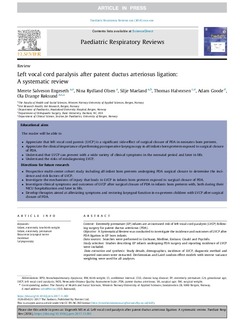| dc.contributor.author | Engeseth, Merete Salveson | |
| dc.contributor.author | Olsen, Nina Rydland | |
| dc.contributor.author | Mæland, Silje | |
| dc.contributor.author | Halvorsen, Thomas | |
| dc.contributor.author | Goode, Adam | |
| dc.contributor.author | Røksund, Ola Drange | |
| dc.date.accessioned | 2019-04-05T07:05:53Z | |
| dc.date.available | 2019-04-05T07:05:53Z | |
| dc.date.created | 2018-01-11T13:21:02Z | |
| dc.date.issued | 2017 | |
| dc.identifier.citation | Engeseth, M. S., Olsen, N. R., Maeland, S., Halvorsen, T., Goode, A., & Røksund, O. D. (2018). Left vocal cord paralysis after patent ductus arteriosus ligation: A systematic review. Paediatric Respiratory Reviews, 27, 74-85. | nb_NO |
| dc.identifier.issn | 1526-0550 | |
| dc.identifier.uri | http://hdl.handle.net/11250/2593391 | |
| dc.description.abstract | Context
Extremely premature (EP) infants are at increased risk of left vocal cord paralysis (LVCP) following surgery for patent ductus arteriosus (PDA).
Objective
A Systematical Review was conducted to investigate the incidence and outcomes of LVCP after PDA ligation in EP born infants.
Data sources
Searches were performed in Cochrane, Medline, Embase, Cinahl and PsycInfo.
Study selection
Studies describing EP infants undergoing PDA surgery and reporting incidence of LVCP were included.
Data extraction and synthesis
Study details, demographics, incidence of LVCP, diagnostic method and reported outcomes were extracted. DerSimonian and Laird random effect models with inverse variance weighting were used for all analyses.
Study appraisal
The Newcastle-Ottawa scale for observational studies was used for quality assessment.
Results
21 publications including 2067 infants were studied. The overall pooled summary estimate of LVCP incidence was 9.0% (95% CI 5.0, 15.0). However, the pooled incidence increased to 32% when only infants examined with laryngoscopy were included. The overall risk ratio for negative outcomes was higher in the LVCP group (2.20, 95% CI 1.69, 2.88, p = 0.01) compared to the non-LVCP-group.
Conclusions
Reported incidence of LVCP varies widely. This may be explained by differences in study designs and lack of routine vocal cords postoperative assessment. LVCP is associated with negative outcomes in EP infants. The understanding of long-term outcomes is scarce. Routine laryngoscopy may be necessary to identify all cases of LVCP, and to provide correct handling for infants with LVCP. | nb_NO |
| dc.language.iso | eng | nb_NO |
| dc.publisher | Elsevier | nb_NO |
| dc.rights | Attribution-NonCommercial-NoDerivatives 4.0 Internasjonal | * |
| dc.rights.uri | http://creativecommons.org/licenses/by-nc-nd/4.0/deed.no | * |
| dc.subject | Infant, extremely low birth weight | nb_NO |
| dc.subject | Infant, extremely premature | nb_NO |
| dc.subject | Recurrent laryngeal nerve | nb_NO |
| dc.subject | Incidence | nb_NO |
| dc.subject | Laryngoscopy | nb_NO |
| dc.title | Left Vocal Cord Paralysis After Patent Ductus Arteriosus Ligation: A Systematic Review. | nb_NO |
| dc.type | Journal article | nb_NO |
| dc.type | Peer reviewed | nb_NO |
| dc.description.version | publishedVersion | nb_NO |
| dc.rights.holder | © 2017 The Authors. | nb_NO |
| dc.subject.nsi | VDP::Medisinske Fag: 700::Klinisk medisinske fag: 750::Pediatri: 760 | nb_NO |
| dc.source.pagenumber | 74-85 | nb_NO |
| dc.source.volume | 27 | nb_NO |
| dc.source.journal | Paediatric Respiratory Reviews | nb_NO |
| dc.identifier.doi | 10.1016/j.prrv.2017.11.001 | |
| dc.identifier.cristin | 1540784 | |
| cristin.unitcode | 203,3,11,0 | |
| cristin.unitname | Institutt for ergo/fysio/radio - Bergen | |
| cristin.ispublished | true | |
| cristin.fulltext | original | |
| cristin.qualitycode | 1 | |

